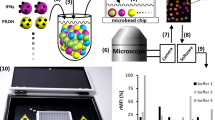Abstract
The specific interaction between sense and antisense peptides was studied by high-performance affinity chromatography (HPAC) and quartz crystal microbalance (QCM) biosensor. Fragment 1–14 of human interferon-β (hIFN-β) was chosen as sense peptide and its three antisense peptides (AS-IFN 1, AS-IFN 2, and AS-IFN 3) were designed according to the degeneracy of genetic codes. The affinity column was prepared with sense peptide as ligand and the affinity chromatographic behavior was evaluated. Glu-substituted antisense peptide (AS-IFN 3) showed the strongest binding to immobilized sense peptide at pH 7.5. A quartz crystal microbalance-flow injection analysis (QCM-FIA) system was introduced to investigate the recognition process in real-time. The equilibrium dissociation constants between sense peptide and AS-IFN 1, AS-IFN 2 and AS-IFN 3 measured 2.08×10−4, 1.31×10−4 and 2.22×10−5 mol/L, respectively. The mechanism study indicated that the specific recognition between sense peptide and AS-IFN 3 was due to sequence-dependent and multi-modal affinity interaction.
Similar content being viewed by others
References
Mekler L B. On the specific selective interaction between amino acid residues of polypeptide chain. Biofizika, 1969, 14: 581–584
Bost K I, Smith E M, Blalock J E. Similarity between the corticotropin (ACTH) receptor and a peptide encoded by an RNA that is complementary to ACTH mRNA. Proc Natl Acad Sci USA, 1985, 82(5): 1372–1375
Chaiken I. Interactions and uses of antisense peptides in affinity technology. J Chromatogr, 1992, 597(1–2): 29–36
Heal J R, Roberts G W, Raynes J G, et al. Specific interactions between sense and complementary peptides: the basis for the proteomic code. ChemBioChem, 2002a, 3(2–3): 136–151
Fassina G, Roller P P, Oison A D, et al. Recognition properties of peptides hydropathically complementary to residues 356–375 of the c-raf protein. J Biol Chem, 1989, 264(19): 11252–11257
Lu F X, Aiyar N, Chaiken I M. Affinity capture of [Arg8] vasopressin-receptor complex using immobilized antisense peptide. Proc Natl Acad Sci USA, 1991, 88(9): 3642–3646
Scapol L, Rappuoli P, Viscomi G C. Purification of recombinant human interferon-β by immobilized antisense peptides. J Chromatogr, 1992, 600(2): 235–242
Davids J W, El-Bakri A, Heal J, et al. Design of antisense (complementary) peptides as selective inhibitors of cytokine interleukin I. Angew Chem Int Ed Engl, 1997, 36(9): 962–967
Heal J R, Bino S, Ray K P, et al. A search within the IL-1 type I receptor reveals a peptide with hydropathic complementarity to the IL-1β trigger loop which binds to IL-1 and inhibits in vitro responses. Mol Immunol, 1999, 36(17): 1141–1148
Bhakoo A, Raynes J G, Heal J R, et al. De-novo design of complementary (antisense) peptide mini-receptor inhibitor of interleukin 18 (IL-18). Mol Immunol, 2004, 41(12): 1217–1224
Heal J R, Roberts G W, Christie G, et al. Inhibition of β-amyloid aggregation and neurotoxicity by complementary (antisense) peptides. ChemBioChem, 2002b, 3(1): 86–92
Zhao R, Fang C L, Yu X, et al. Screening of inhibitors for influenza A virus using high-performance affinity chromatography and combinatorial peptide libraries. J Chromatogr A, 2005, 1064(1): 59–66
Zhao R, Yu X, Liu H, et al. Study on the degeneracy of antisense peptides using affinity chromatography. J Chromatogr A, 2001, 913(1–2): 421–428
Liu T, Tang J, Han M, et al. Surface modification of nanogold particles in DNA detection with quartz crystal microbalance. Chin Sci Bull, 2003, 48(9): 873–875
Hengerer A, Decker J, Prohaska E, et al. Quartz crystal microbalance (QCM) as a device for the screening of phage libraries. Biosens Bioelectron, 1999, 14(2): 139–144
Atherton E, Sheppard R C. Solid Phase Peptide Synthesis: A practical Approach. Oxford: IRL Press, 1989
Keen R T. Determination of oxetanes. Anal Chem, 1957, 29(7): 1041–1044
Liu Y, Yu X, Zhao R, et al. Quartz crystal biosensor for real-time monitoring of molecular recognition between protein and small molecular medicinal agents. Biosens Bioelectron, 2003, 19(1): 9–19
Sundberg L, Porath I. Preparation of adsorbents for biospecific affinity chromatography: I. Attachment of group-containing ligands to insoluble polymers by means of bifunctional oxiranes. J Chromatogr, 1974, 90(1): 87–98
Rickert J, Brecht A, Gopel W. Quartz crystal microbalances for quantitative biosensing and characterizing protein multilayers. Biosens Bioelectron, 1997, 12(7): 567–575
Bizet K, Gabrielli C, Perrot H. Immunodetection by quartz crystal microbalance—A new approach for direct detection of rabbit IgG and peroxidase. Appl Biochem Biotech, 2000, 89(2–3): 139–149
Muramatsu H, Kim J M, Chang S M. Quartz-crystal sensors for biosensing and chemical analysis. Anal Bioanal Chem, 2002, 372(2): 314–321
Nakamura C, Song S H, Chang S M, et al. Quartz crystal microbalance sensor targeting low molecular weight compounds using oligopeptide binder and peptide-imniobilized latex beads. Anal Chim Acta, 2002, 469(2): 183–188
Melles E, Anderson H, Wallinder D, et al. Electroimmobilization of proinsulin C-peptide to a quartz crystal microbalance sensor chip for protein affinity purification. Anal Biochem, 2005, 341(1): 89–93
Carmon K S, Baltus R E, Luck L A. A biosensor for estrogenic substances using the quartz crystal microbalance. Anal Biochem, 2005, 345(2): 277–283
Park I S, Kim N. Thiolated Salmonella antibody immobilization onto the gold surface of piezoelectric quartz crystal. Biosens Bioelectron, 1998, 13(10): 1091–1097
Zhang H W, Zhao R, Chen Z Y, et al. QCM-FIA with PGMA coating for dynamic interaction study of heparin and antithrombin III. Biosens Bioelectron, 2005, 21(1): 121–127
Author information
Authors and Affiliations
Corresponding author
Additional information
Supported by the National Natural Science Foundation of China (Grant Nos. 20575072, 20435030 and 90408018) and the Chinese Academy of Sciences (Grant No. KJCX2-SW-H06)
About this article
Cite this article
Luo, J., Huang, Y., Xiong, S. et al. Study on peptide-peptide interaction using high-performance affinity chromatography and quartz crystal microbalance biosensor. CHINESE SCI BULL 52, 1311–1319 (2007). https://doi.org/10.1007/s11434-007-0175-3
Received:
Accepted:
Issue Date:
DOI: https://doi.org/10.1007/s11434-007-0175-3




